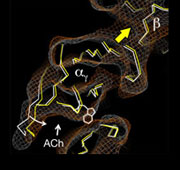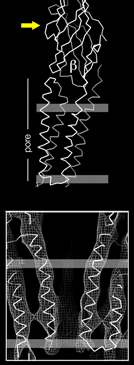Synaptic transmission
The open-channel form of the receptor exists for only about 1ms following synaptic activation by ACh. To image this transient form using the membrane tubes, it first needs to be created and caught by spray-freeze-trapping, a technique which recapitulates almost perfectly the activation conditions that apply in vivo.
A 6Å structure, obtained by this approach, shows that opening of the channel takes place by a concerted conformational change involving a number of small inter-dependent movements. ACh, on coordinating with amino acids in the αγ binding site, triggers a small rearrangement of the surrounding pair of β sheets. The β subunit is thereby displaced by about 1Å, causing its membrane part to tilt outward. Tilting of the membrane part of β destabilises the tight hydrophobic girdle, forming the gate, and the slightly bent pore-lining helices are freed to adopt more energetically favoured, straight conformations. As a result, the hydrophobic constriction disappears, and ions readily pass through.
Key publications:
Unwin, N. Acetylcholine receptor imaged in the open state. Nature 373, 37-43 (1995). (pdf)
Unwin, N. and Fujiyoshi, Y. Gating movement of acetylcholine receptor caught by plunge-freezing. J. Mol. Biol. 422, 617-634 (2012). (pdf)


